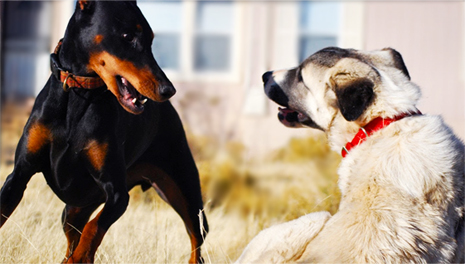Fights in Pack - Dominance vs Submissive Gesture and My Big Mistake
Nature's Rule for Pack Hierarchy and My BIG Mistake
Do not make the same mistake as I did by getting into their fights to stop the war. To many dog lovers across the globe this post may sound a bit too off-beat as I have always spoken against cruelty to animals and saving lives...
Well, this post is published followed by a few months of critically studying behavioral components, dominance signals in dogs that live in pack - in houses or in the wild. I have also consulted documents of several canine psychologists and behaviorists, including Nick White and the genius Professor Stanley Coren and several others before coming up with this post.
I suggest dog owners - especially those who have more than one dog - not to tread into the conflicts between dogs. The situation may worsen up, not just because you may be hurt badly, but because by interfering you will actually prevent them from framing a natural hierarchical structure. People who share lives with dogs should know that there are "set of natural rules" that act as determinants of "dominance", "ownership" and "territoriality".
Conflicts between two dogs in a pack usually starts, progresses and ends based on these natural rules. And there are very rare instances of big blood shed. Often times there's nothing more than small wounds, punctures and cuts, which are not usually fatal. These are situations when dogs should be better left alone to fight and things will be sorted out naturally, with one of them exhibiting submissive gestures. The moment one shows submission and backs off, the other dog usually stops his attacks. This submission of one dog automatically places the other dog higher in the natural pack hierarchy, which he was fighting for - the "Dominance" in this case.
What mistake I did?
Some of my readers may have this question now... what was my mistake with Reva and Rechie. The situation was little different. It wasn't a fight for position, but for ownership.
Mistake 1: I pushed them into competitive play (fetching a single ball and there were two dogs), which generated a fight for ownership of the property (ball).
Mistake 2: I got into their conflict to stop them and ended up with some minor wounds that required stitches.
However, in continuation with my Mistake 2, the wounds on my palm, hands and face, and some cuts in their bodies here and there were not the points of concern. By interfering I could set them apart, locked them in separation for a couple of hours, but they could not determine who among them were dominant. The fight did not end naturally with one being submissive. Which means they could not instinctually use the "natural rules" for determining the dominant member of the pack. Therefore, there was always high chance for re-occurrence of similar fights again in their life time.
Here a better understanding of Why Clashes Occur in a Pack could be found.
Dominance vs Submission - Does that work for all dogs?
As long as the dogs are properly bred by educated and sensible breeder things should work fine. Incorrectly bred specimens will fail to understand their limit and will not be submissive. This indicates a tendency to disregard the signals to stop and natural rules. Correctly combined genes should strike a proper behavioral balance. Aggression and Submission are two most significant component of temperament that are governed by genes. Hyper-submissive nature and hyper-aggressiveness are as undesirable as hypo-submissive nature and hypo-aggressiveness. Conflicts among dogs with imbalanced behavioral configuration can be fatally dangerous without human intervention. Dog breeding is an art and a science both... rather a "scientific art" or an "artistic science". Science of Dog Breeding needs to be considered seriously. It is not everybody's cup of tea. Dog breeding for making money has always ended up with wrong types of progenitors, with major and suppressed or visible problems either related to physical or physiological or psychological. A related study on Role of Gene in The Character of a Dog.
























0 comments:
Post a Comment